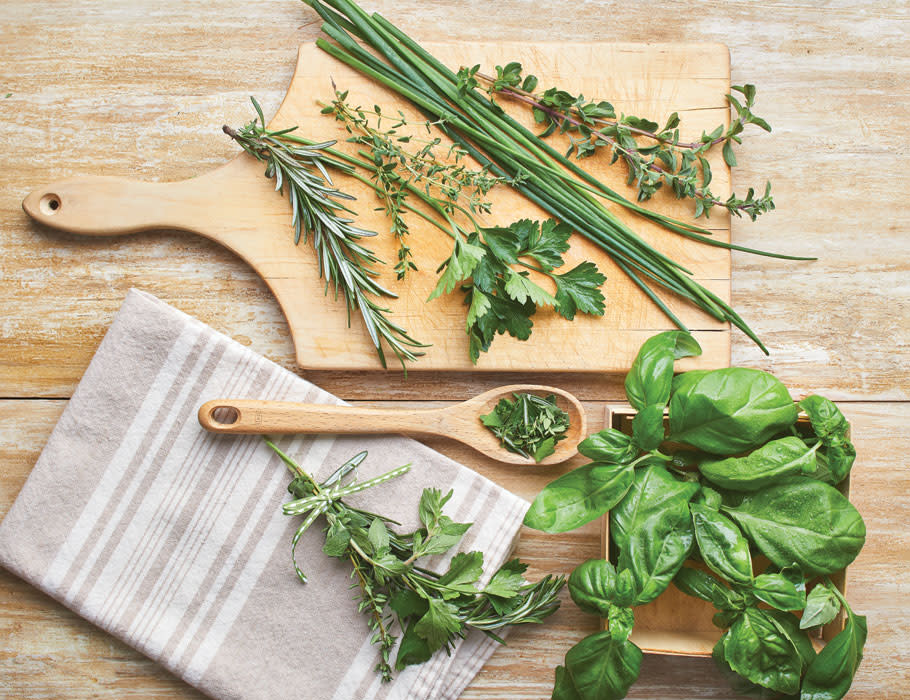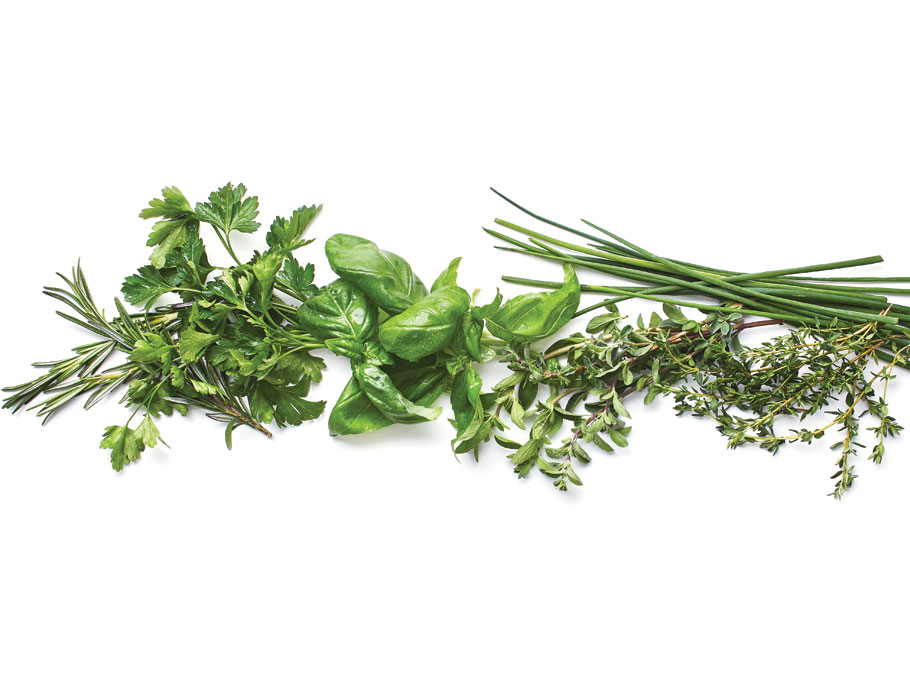All About Herbs
Fresh herbs used to mean curly parsley on a plate, but times have changed. Taste how these six flavorful plants have impacted the way we cook. Here's everything you need to know about storing, cleaning, and cooking with herbs.
by Pamela Killeen

(Note: This post contains affiliate links. As an Amazon Associate, we earn from qualifying purchases made through affiliate links.)
We know we say it a lot — fresh herbs really add to the flavor of a dish. Choosing among them can be overwhelming, though. To clear up any confusion, here’s the lowdown on six basic herbs you should use when cooking.
Surprisingly, the most common cooking herbs come from just two plant families: mint and parsley. And of the herbs we’re focusing on, chives are the only black sheep — they’re in the allium (onion) family. In terms of flavor, you can classify herbs into three categories: pungent, mild, and sweet. When choosing one for cooking, select the herb that complements the dish you’re making without overpowering other ingredients. If it’s one of the “pungent” herbs, use a light touch when adding it to a dish. And to make sure that you’re always well-stocked, try growing a simple container garden of your own.
Herbs are very simple to use. Here’s what you really need to know when cooking with them.
How to Clean Herbs
The easiest way to clean herbs is to plunge them in cold water until dirt-free, then dry — a couple of turns in a salad spinner works best. Line the spinner basket with paper towels to soak up moisture and prevent bruising.
What to do with those stems
If the herb is soft stemmed, like parsley, the whole sprig can be used. But if the stem is woody, as with rosemary, only use the leaves. Reserve the stems to flavor soups and stocks.
How to Cook with Herbs
When cooking with fresh herbs, it’s best to add them at the end of the recipe so heat doesn’t destroy their bright color and flavor. (Rosemary, sage, and thyme are exceptions. Their flavors hold up well during cooking.) If substituting fresh herbs for dried, the general rule is to use about three times the amount — for instance, one tablespoon of fresh equals one teaspoon of dried.
Classic Herb Blends
Bouquet garni includes bay leaf, parsley, and thyme. The herbs are usually bundled in cheesecloth, then steeped in liquid and removed before serving. Fines herbes consists of finely chopped tarragon, parsley, chives, and chervil. This blend is added to a dish just before serving. Herbes de Provence is a mixture of dried herbs, and comes in several blends. It often contains thyme, lavender, marjoram, rosemary, and summer savory
How to Store Herbs
It’s important to remember that moisture causes fresh herbs to deteriorate quickly, so don’t wash them until ready to use. As for how to store them, keep those with long stems in a jar or vase (like fresh-cut flowers), tightly covered with a plastic bag, and change the water every couple of days. Small stemmed sprigs will be fine stored in an airtight container. And since most herbs thrive at around 40 degrees, keep them in the refrigerator’s crisper drawer. In general, herbs keep one to two weeks, but the more delicate its leaves, the shorter its shelf life.
You can also use a herb keeper and storage container. These are perfect for use with a variety of herbs and even asparagus. They're slim and fit perfectly on the shelf in the refrigerator.
How to Store Fresh Basil
Trim the stems, place the sprigs in a jar with 1–2 inches of water, then loosely cover the leaves with a plastic bag. Store the jar on your counter at room temperature out of direct sunlight, and change the water every day or two.

The Six Most Commonly Used Herbs

Rosemary
Pungent ROSEMARY is one of our favorite herbs. Incredibly versatile, its pine-like flavor complements everything from meat to vegetables to bread. It’s also an exciting addition to desserts — sprigs are sometimes steeped in liquids to add flavor to custards or sorbets. Rosemary can easily tolerate heat from cooking, but use sparingly — its strong flavor quickly takes over. Extra-thick stems work great as grilling skewers — but leave the tips on for decoration.
QUICK ROSEMARY TIP: Strip needles from the stems and mince. If the needles are too coarse, their texture can be off-putting.
SWEET BASIL
SWEET BASIL, with its undertones of anise and clove, is the most common of over 150 varieties. Tomatoes are basil’s classic companion, and pesto couldn’t exist without it. When raw, basil can be pretty strong. Cooking mellows it out, but add toward the end — heat causes it to turn black. Dried basil has lost much of its flavor, so use fresh when you can. And since the leaves bruise easily, chop with a sharp knife, or tear them instead.
QUICK BASIL TIP: To chiffonade [shihf-uh-NAHD], roll leaves like a cigar, then thinly slice with a knife.
Chives
Of the pungent herbs, CHIVES are on the mild side. There are two varieties: Onion chives are hollow in the middle with purple blossoms, while garlic chives are flat with white blossoms. Chive greens are sometimes blanched and used as “string” to tie bundles of vegetables together. The blossoms are edible, too, but they’re stronger tasting than the greens. Use blossoms as a garnish, but discard the green it grows on — it’s too tough to eat.
QUICK CHIVES TIP: Snip chives with kitchen shears to help preserve their natural oils.
PARSLEY
Mild flavored flat- (or Italian) and curly-leaf PARSLEY differ more in texture than taste. Parsley is used to flavor all kinds of dishes and is a main ingredient in persillade [pehr-see-YAHD], a garnish including garlic or shallot. Gremolata [greh-moh-LAH-tah] is the same thing, but with lemon zest added. While many think of flat leaf as “gourmet” parsley, the curly variety is more popular in Europe — flat leaf looks too much like fool’s parsley, a poisonous fake that grows there.
QUICK PARSLEY TIP: Use kitchen shears to snip parsley in a small bowl. It helps keep the pieces contained.
OREGANO
Understanding OREGANO can get a bit confusing. The pungent, spicy herb we associate with pizza is Greek oregano. It’s sometimes referred to as rigani and usually sold dried. The oregano most often sold fresh is known as “common oregano.” Unlike Greek oregano, whose flavor can easily overpower, common oregano is rather mild. To insure its delicate flavor isn’t lost during cooking, add common oregano just before serving the dish.
QUICK OREGANO TIP: Oregano is one of the sandier herbs, so an extra dunk or two in water may be necessary to clean it.
THYME
There are many varieties of THYME, but only two that regularly appear in the kitchen: lemon and garden (or common). Lemon thyme imparts subtle citrus flavor and aroma — it’s best used to garnish or finish a dish. English thyme is the most readily available variety of garden thyme. Like rosemary, the pungent flavor of garden thyme can easily withstand cooking. Thyme is one of the classic ingredients in a bouquet garni and is essential for flavoring broths and stocks.
QUICK THYME TIP: To remove thyme leaves, hold sprigs by the tip, slide your fingers down the stems, and strip off the leaves.
Product Recommendations
Interested in cooking? Need some supplies?
Check out some of the tools we like. All products featured on Cuisine at Home are independently selected by our editors; we may earn an affiliate commission from qualifying purchases through our links.